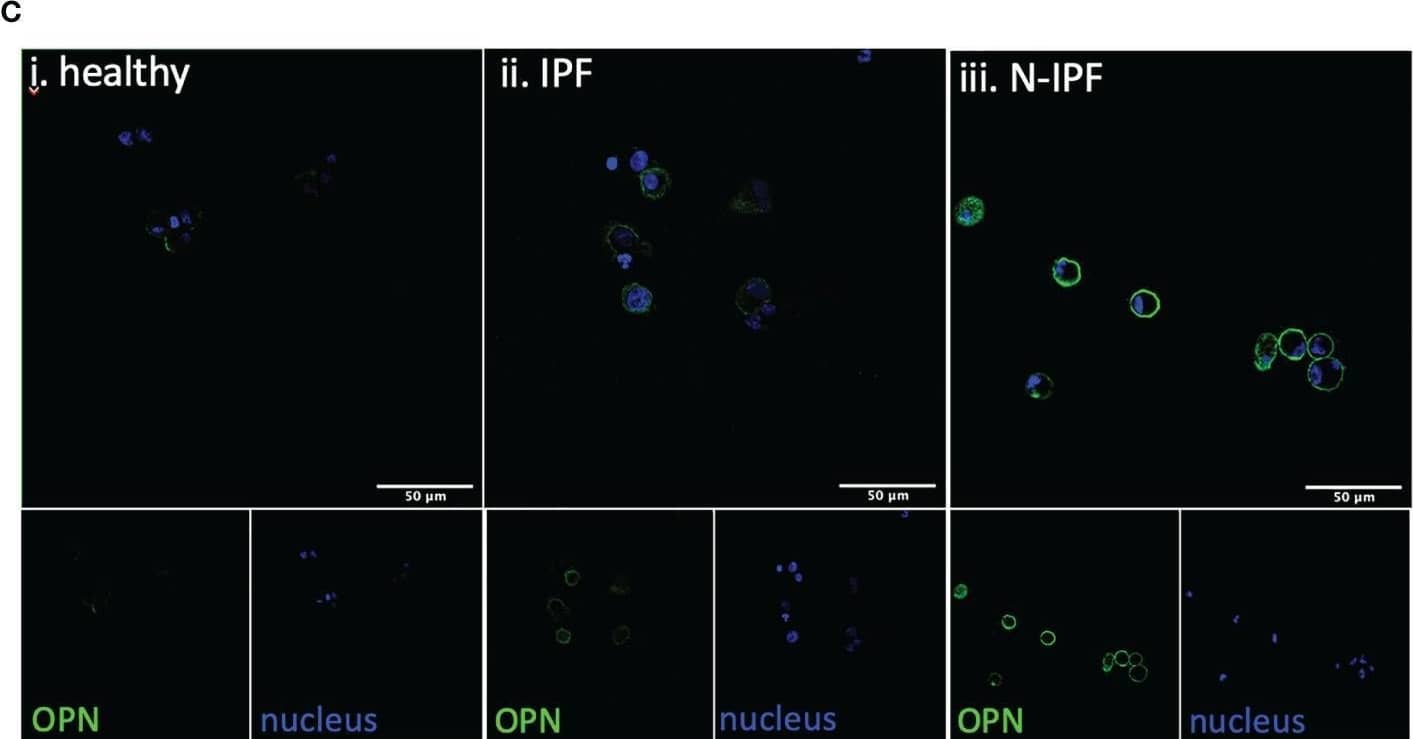Human Osteopontin/OPN Antibody Summary
Ile17-Asn300
Accession # NP_000573.1
Applications
Please Note: Optimal dilutions should be determined by each laboratory for each application. General Protocols are available in the Technical Information section on our website.
Scientific Data
 View Larger
View Larger
Osteopontin/OPN in Human Breast Cancer Tissue. Osteopontin/OPN was detected in immersion fixed paraffin-embedded sections of human breast cancer tissue using Mouse Anti-Human Osteopontin/OPN Monoclonal Antibody (Catalog # MAB1433) at 25 µg/mL overnight at 4 °C. Tissue was stained using the Anti-Mouse HRP-DAB Cell & Tissue Staining Kit (brown; Catalog # CTS002) and counterstained with hematoxylin (blue). Specific staining was localized to cytoplasm in epithelial cells. View our protocol for Chromogenic IHC Staining of Paraffin-embedded Tissue Sections.
 View Larger
View Larger
Detection of Osteopontin/OPN by Immunocytochemistry/ Immunofluorescence SPP1 and OPN expression in BAL cells. (A) SSP1 relative mRNA levels in IPF and N-IPF relative to healthy (Brown-Forsythe Anova, with individual comparisons), (B) Violin plots of mean OPN expression/cell per disease group (Kruskal-Wallis test and individual comparisons) and (C) Typical Images of BAL cytospins stained with anti-human OPN antibody and ToPro-633 nuclear stain in (i) healthy, (ii) IPF and (iii) N-IPF samples (*p < 0.05, **P < 0.01, ****p < 0.0001). Image collected and cropped by CiteAb from the following open publication (https://pubmed.ncbi.nlm.nih.gov/34867934), licensed under a CC-BY license. Not internally tested by R&D Systems.
Reconstitution Calculator
Preparation and Storage
- 12 months from date of receipt, -20 to -70 °C as supplied.
- 1 month, 2 to 8 °C under sterile conditions after reconstitution.
- 6 months, -20 to -70 °C under sterile conditions after reconstitution.
Background: Osteopontin/OPN
Osteopontin (OPN), previously called SPP1 (secreted phosphoprotein 1), Eta1(early T lymphocyte activation 1) or BSP (bone sialoprotein), is a secreted molecule in the SIBLING (small integrin binding ligand N-linked glycoprotein) family of noncollagenous matricellular proteins (1‑3). Human OPN is synthesized as a 317 aminoacid (aa) precursor protein with a 16 aa signal peptide and a 301 aa mature protein (3). Mature human OPN shares 64% and 62% aa sequence identity with mouse and rat OPN, respectively. OPN is highly acidic and has 26 potential Ser/Thr phosphorylation sites and a C‑terminal CD44 binding site (1‑4). Depending on tissue-specific modification by O- and N‑glycosylation, sulfation, phosphorylation and transglutamination, OPN can be detected at 45‑75 kDa (5, 6). The central region of OPN contains RGD and nonRGD binding sites for multiple integrins (3, 4). Adjacent to the RGD motif is the sequence SVVYGLR (SLAYGLR in mouse) which serves as a cryptic binding site for additional integrins: it is masked in full length OPN but is exposed following OPN cleavage by thrombin in tumors and sites of tissue injury
(6‑8). OPN can also be cleaved by MMP3, 7, 9, and 12 within the SVVYGLR motif and at sites closer to the C‑terminus (8, 9). OPN is widely expressed and is prominent in mineralized tissues. It inhibits bone mineralization and kidney stone formation, and promotes inflammation and cell adhesion and migration (1, 2, 4, 6). Its expression is up‑regulated during inflammation, obesity, atherosclerosis, cancer, and tissue damage, and contributes to the pathophysiology of these conditions (1, 2, 6, 9, 10).
- Scatena, M. et al. (2007) Arterioscler. Thromb. Vasc. Biol. 27:2302.
- Rangaswami, H. et al. (2006) Trends Cell Biol. 16:79.
- Young, M.F. et al. (1990) Genomics 7:491.
- Weber, G.F. et al. (2002) J. Leukoc. Biol. 72:752.
- Keykhosravani, M. et al. (2005) Biochemistry 44:6990.
- Kazanecki, C.C. et al. (2007) J. Cell. Biochem. 102:912.
- Senger, D.R. et al. (1994) Mol. Biol. Cell 5:565.
- Yokosaki, Y. et al. (2005) Matrix Biol. 24:418.
- Takafuji, V. et al. (2007) Oncogene 26:6361.
- Kiefer, F.W. et al. (2010) Diabetes 59:935.
Product Datasheets
Citations for Human Osteopontin/OPN Antibody
R&D Systems personnel manually curate a database that contains references using R&D Systems products. The data collected includes not only links to publications in PubMed, but also provides information about sample types, species, and experimental conditions.
6
Citations: Showing 1 - 6
Filter your results:
Filter by:
-
AntagomiR-29b inhibits vascular and valvular calcification and improves heart function in rats
Authors: M Fang, K Liu, X Li, Y Wang, W Li, B Li
J. Cell. Mol. Med., 2020-08-26;0(0):.
Species: Rat
Sample Types: Whole Tissue
Applications: IHC -
Quantitative expression of osteopontin in nasal mucosa of patients with allergic rhinitis: effects of pollen exposure and nasal glucocorticoid treatment
Authors: Serena E O'Neil, Carina Malmhäll, Konstantinos Samitas, Teet Pullerits, Apostolos Bossios, Jan Lötvall
Allergy, Asthma & Clinical Immunology
-
Osteopontin expression and relation to disease severity in human asthma.
Authors: Samitas K, Zervas E, Vittorakis S, Semitekolou M, Alissafi T, Bossios A, Gogos H, Economidou E, Lotvall J, Xanthou G, Panoutsakopoulou V, Gaga M
Eur. Respir. J., 2010-06-18;37(2):331-41.
Species: Human
Sample Types: Whole Tissue
Applications: IHC-P -
Primary Breast Carcinoma: Association of Mammographic Calcifications with Osteopontin Expression
Authors: Xiao Wang, Lan Chao, Guohui Ma, Liansheng Chen, Guangchao Jin, Mei Hua et al.
Radiology
-
The effect of human osteoblasts on proliferation and neo-vessel formation of human umbilical vein endothelial cells in a long-term 3D co-culture on polyurethane scaffolds.
Authors: Hofmann A, Ritz U, Verrier S, Eglin D, Alini M, Fuchs S, Kirkpatrick CJ, Rommens PM
Biomaterials, 2008-08-09;29(31):4217-26.
Species: Human
Sample Types: Whole Cells
Applications: ICC -
Osteopontin has a crucial role in allergic airway disease through regulation of dendritic cell subsets.
Authors: Xanthou G, Alissafi T, Semitekolou M, Simoes DC, Economidou E, Gaga M, Lambrecht BN, Lloyd CM, Panoutsakopoulou V
Nat. Med., 2007-04-15;13(5):570-8.
Species: Human
Sample Types: Whole Tissue
Applications: IHC-P
FAQs
No product specific FAQs exist for this product, however you may
View all Antibody FAQsReviews for Human Osteopontin/OPN Antibody
Average Rating: 4 (Based on 1 Review)
Have you used Human Osteopontin/OPN Antibody?
Submit a review and receive an Amazon gift card.
$25/€18/£15/$25CAN/¥75 Yuan/¥2500 Yen for a review with an image
$10/€7/£6/$10 CAD/¥70 Yuan/¥1110 Yen for a review without an image
Filter by:


